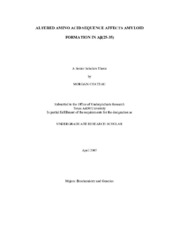Altered Amino Acid Sequence Affects Amyloid Formation In Aβ(25-35)
Abstract
Many neurodegenerative diseases are associated with protein misfolding where the protein forms β-sheet rich polymers called amyloid. Alzheimer’s disease (AD) is an amyloid aggregation disease involving the Aβ(1-42) peptide fragment of the Amyloid Precursor Protein (APP) in the nervous tissue of the brain. Within the peptide there are regions thought to be more critical for amyloid formation; one of which is Aβ(25-35). This sequence has the ability to form amyloid at sufficient peptide concentrations. Within this region, residues 33-35 have been found by terminal deletions to be a core region (1), the residues necessary for amyloid formation. Using Cys-scanning mutagenesis the estimated core region (31-34) is slightly different. Previous papers have shown, the peptide loses the ability to form amyloid fibrils when the sequence of amino acids is changed (2). For this experiment, four different Aβ(25-35) sequences were tested, each having the same composition but a different sequence. FPLC was used in conjunction with Thioflavin-T fluorescence to monitor amyloid development. The results showed a definite effect on amyloid formation as compared to wild type. Sequence S-N showed nearly no change in behavior. Sequence S-M appeared to loose all amyloid forming ability. The remaining two sequences were unable to remain in solution long enough to be accurately tested.
Citation
Chateau, Morgan (2007). Altered Amino Acid Sequence Affects Amyloid Formation In Aβ(25-35). Available electronically from https : / /hdl .handle .net /1969 .1 /5722.


